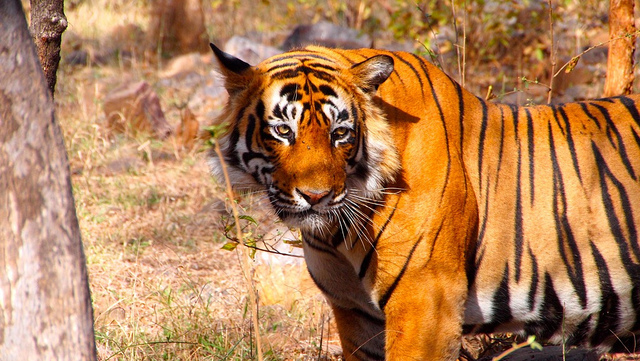On land or underwater we share our planet with some wonderful creatures. And whilst TV documentaries and social media do their best to educate us about our co-habitants on earth and partially satisfy our curiousity by bringing the wild outdoors into our living rooms, there is still nothing like seeing wildlife up close and in the flesh in its natural habitat. If zoos make you snooze, then it’s time to indulge in a spot of wildlife tourism, which can be local or in some far-flung destination, and as organised as a Safari, or as simple as a walk in the woods. Take Asia, for example. The diversity of climate and geography in the world’s largest continent is reflected in its abundant wildlife. In India alone, there are 350 species of mammals, 2100 types of birds, 350 varieties of reptiles and countless insects.
1) India’s Tiger Reserves
With less than 2,000 tigers remaining in its shrinking jungles, the Indian government needed to act or the species faced extinction. Native tigers can now be found in 38,000 kilometres of protected wilderness, across 500 parks and sanctuaries – many of them providing high standard tourist accommodation.
2) Rhino rambles in India
Feed, wash down and then ride magnificent elephants bare back through India’s Kaziranga National Park in search of the one-horned Rhino. Thankfully the numbers of this once threatened species are on the up, and sightings are virtually guaranteed.
3) Rural Borneo
Most people’s experience of an Orangutan extends to a visit to the local zoo or from the Clint Eastwood film, Every Which Way But Loose, which stars an Orangutan by the name of Clyde. Unlike the movie star, these smartest of primates – known as the ‘old man of the forest’ – are generally shy and not that easy to find. The effort is well worth it though – you can find more information here: http://news.freedomasia.co.uk/get-away-from-it-all-in-rural-borneo/3043/
4) Leopard spotting in Sri Lanka
With its coastal location Yala National Park, the country’s number one leopard sanctuary, boasts an idyllic location. Summer is the best time to visit as the undergrowth has died down, making the cats much easier to see. Over a five-day period there is reported to be a 90% chance of seeing one of the big cats on the prowl.
5) China’s National Treasure
More than 30 per cent of the world’s population can be found in the Chinese province of Sichuan. Wolong National Natural Reserve is the earliest, largest (at just under half-a-million acres) and best-known of the many sanctuaries there, with plenty of opportunities to see both wild and captive giant pandas roaming around. Find out more about these beautiful creatures: http://worldwildlife.org/species/giant-panda
Photo credit: tiger

Leave a Reply